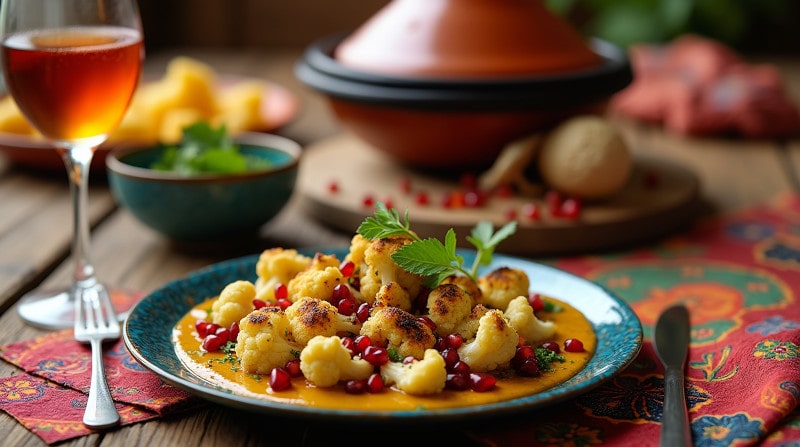An aromatic oriental dish that harmonises perfectly with an Orange Wine from Styria
Roasted cauliflower with a nutty tahini sauce, fresh herbs and sweet and sour pomegranate seeds: this vegetarian dish brings depth, texture and a variety of flavours to the plate – and calls for an exceptional wine. An orange wine with structure and herbal spice provides the ideal balance to the earthy, nutty and fruity flavours. Roasted cauliflower with a nutty tahini sauce, fresh herbs and sweet and sour pomegranate seeds: this vegetarian dish brings depth, texture and a variety of flavours to the plate – and calls for an exceptional wine.
🥂 Ideal wine pairing: Orange wine from Styria (e.g. Sauvignon Blanc with mash fermentation)
An Orange Wine from Styria, for example from Sauvignon Blanc, is particularly full of character thanks to its mash fermentation: with herbal spice, ripe fruit flavours, lively acidity and fine tannins. These characteristics go perfectly with the roasted flavour of the cauliflower and the creamy, sesame-accented tahini sauce. The phenolic structure of the wine easily takes on the earthy depth of the vegetables and the light sweetness of the pomegranate seeds, while the acidity provides freshness and elegantly combines the flavours.
🍷 Further suitable wine recommendations
1. Ribolla Gialla Orange Wine – Friuli Venezia Giulia IGT (Italy) This classic macerated orange wine from northern Italy is characterised by dried herbs, orange peel and a distinctive tannin structure. Its tart elegance emphasises the nutty depth of the tahini sauce and contrasts pleasantly with the fruity pomegranate seeds.
2. Pinot Gris Orange – Baden QbA (Germany) A mash-fermented Pinot Gris with soft tannins, ripe pear, rosehip and spice. Ideal with the warm, autumnal flavour of cauliflower, without overpowering the dish. Particularly harmonious in combination with fresh parsley and coriander.
3. Malvasia di Candia Orange – Emilia IGT (Italy) With a pronounced floral and almond-like aroma, this wine is a real food-pairing star. Its creamy texture makes it the ideal partner for tahini and baked vegetables – complex and wonderfully drinkable.
4. Muscat Orange – Vin de France (France) A macerated Muscat surprises with floral expressiveness and spicy grip. The intense flavour goes well with oriental-inspired dishes and plays with the freshness of the pomegranate seeds.
5. Welschriesling Orange – Burgenland (Austria) The orange version of Welschriesling has apple peel, herbs and a hint of oxidative depth – ideal with roasted vegetables with roasted flavours and herbal spice.
The recipe:
Roasted cauliflower with tahini sauce & pomegranate seeds
Cooking utensils
- 1 Baking tray with baking paper
- 1 Knife & chopping board
- 1 Mixing bowl
- 1 Small blender jug for sauce
Ingredients
For the cauliflower:
- 1 small cauliflower divided into florets
- 2 Tbsp olive oil
- 1 teaspoon smoked paprika powder
- Salt & pepper
For the tahini sauce:
- 2 EL Tahini Sesame paste
- Juice ½ lemon
- 1 Garlic clove finely grated
- 3 -4 tablespoons water
- Salt to taste
Toppings:
- 2 Tbsp pomegranate seeds
- 1 tbsp chopped fresh mint or parsley
- Black sesame seeds optional
Preparation
Roasting cauliflower
- Preheat the oven to 200 °C.
- Mix the cauliflower with olive oil, paprika powder, salt & pepper and place on a baking tray.
- Roast for approx. 25 minutes until the florets are golden brown.
Prepare the tahini sauce
- Mix all the ingredients in a small bowl, dilute with water if necessary until creamy.
- Season to taste with salt.
Sideboards
- Arrange the cauliflower on plates, drizzle with the tahini sauce.
- Sprinkle with pomegranate seeds, herbs and sesame seeds.
Recommended side dishes
- Flatbread with cumin
- Bulgur salad with mint
- Hummus or baba ghanoush

